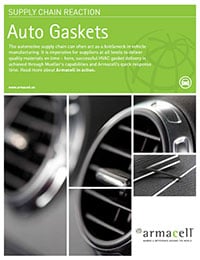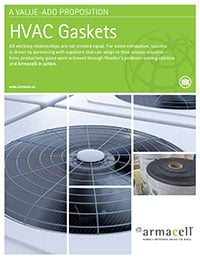.jpg?width=512&name=unnamed%20(8).jpg)
Transportation is a massive and ever-changing industry, with countless opportunities for profit. However, you can only do this by creating products of the highest quality. Quality starts with materials, which means you have to make the right choices when it comes to parts.
In this guide, the transportation material experts at Mueller take you step-by-step through the factors and questions to consider for choosing the best materials. When you have the best materials, you can create the best products.
Factors to Consider
What Are the Best Gasketing and Sealing Materials for Automotive Applications?
How Do I Choose the Best Material for Post Production Noise Issues?
What Are the Differences Between Polyurethane Foam & Non-Woven Materials?
How Do I Select the Best PVC Foam for My Application?
How Do I Choose the Best Adhesive Type?
Why Do Low VOC Materials Matter in Automotive Applications?
Should I Use Domestic or Imported Materials?
How Can I Get the Best Cost with a Custom Solutions Team?
How Do I Choose the Right Materials for My Application?
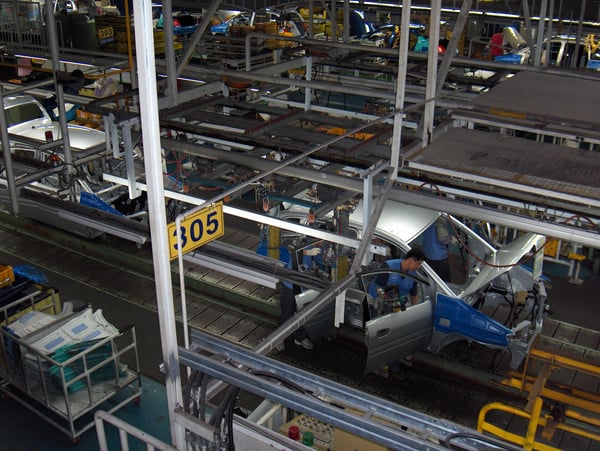
What Are the Best Gasketing and Sealing Materials for Automotive Applications?
Gaskets and seals are typically the source of issues for products in many automotive applications.
Gasketing and sealing applications can make or break a product’s performance and user experience. Therefore, when you’re considering the right material for your job, it’s important to understand several factors such as:
- Compression Level
- Gap Space
- Aesthetics
- Product Surface
- Industry Standards
- Cost
These factors are applicable to the two main types of gasket and seal materials: gap fillers and adhesives.
Gap fillers include materials such as open-cell polyurethane foam, crushed EPDM foam, and ultra-high-molecular-weight (UHMW) materials, like films. These products fill a variety of gap lengths to stop rattling, squeaking, or rubbing.
Adhesives include materials like flocking tape and can be used alongside materials like felt and other non-wovens. Adhesives work best in spaces that are too small for gap fillers or where components need to be reattached to one another.
Choosing the right material for gasketing and sealing applications in the automotive industry is crucial. These materials affect the performance and user experience of the products you create, as well as determining the lifespan of a product and its components.
.jpg?width=512&name=unnamed%20(6).jpg)
How Do I Choose the Best Material for Post-Production Noise Issues?
Now that we’ve addressed the best gasketing and sealing materials for noise issues, it’s time to discuss how to choose a material that suits your needs.
If you identify noise issues in your product during post-production testing, you need to formulate a solution quickly. There are materials to solve for issues ranging from two components rubbing together in a product during the testing phase to products affected by the environment while being used by a customer.
There are a few questions to ask yourself when making a decision about materials:
- How big of a gap is there in the product?
- What environmental issues will it be exposed to?
- Does our supplier have materials in stock?
- What materials are readily available?
You can solve any noise issue in your products by understanding the materials discussed in the previous section, asking yourself these key questions, and working with a manufacturer that stocks and is knowledgeable about the solution you need.
.jpg?width=512&name=unnamed%20(9).jpg)
What Are the Differences Between Polyurethane Foam & Non-Woven Materials?
Two materials we’ve already mentioned, polyurethane foam and non-woven materials, have similar characteristics and applications. However, they are not interchangeable, and learning the differences between the two will make your material selection process simpler.
There are two main types of open-cell polyurethane foam: ether-based and ester-based. These foam types are used mainly in acoustic applications, but can also be used for thermal insulation or moisture and dust-sealing applications.
Polyester non-wovens most directly relate to polyurethane foams for thermoacoustic applications. Some types of non-woven materials can be tuned to fit a product’s need specifically, but all have qualities that allow them to dry quickly and insulate both heat and noise.
It’s crucial to understand the acoustic and thermal targets of a product when you decide between polyurethane open-cell foams and PET non-wovens in thermoacoustic applications. You can use that information to narrow down material choices before examining other relevant properties, like moisture resistance. Then, assess solutions based on the problem you’re solving for using all this information.
Ultimately, the specific requirements you need to meet are going to drive your decision when comparing polyurethane foams and non-woven materials. Making the right choice based on the above factors can extend the lifespan of your product and enhance the user experience.
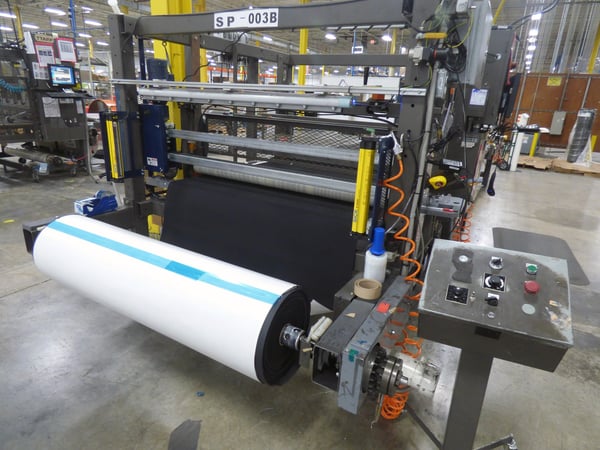
How Do I Select the Best PVC Foam for My Application?
Another commonly used material across multiple applications is PVC foam, a highly specified product that can serve several different industries.
This foam can be utilized for sealing, gasketing, or insulating applications. It cushions against shock and vibration, can seal out environmental factors like moisture and dust, service a wide range of temperatures, and much more.
However, since this material is so versatile, selecting the right type of PVC foam can be challenging. Let’s examine a few ways to ensure you choose the right foam type.
Know the Application
As stated earlier, PVC foam is a very versatile material that can be specified to suit almost any need. However, there are six common applications for this type of foam that can guide your selection process: appliances, automotive, topper seal, gasketing, HVAC, and weather stripping.
Know the PVC Foam Types
There are five foam types that can be used to solve for the applications discussed above. The five foam types are:
- General-Purpose / Low-Grade PVC Foam: This foam type can be used in applications that require a seal or cushioning.
- Specialty PVC Foam: This foam type can be used for applications that require low force compression, thermal insulation, anti-condensation, glass or non-porous surfaces, and UL compliance.
- Automotive PVC Foam: These foams are like specialty PVC foams, except this type is designed to meet specific automotive industry specifications.
- HVAC and Appliance PVC Foam: These foam types help with thermal insulation and prevent moisture buildup on surfaces they are applied to, as well as reducing vibration and deadening sound.
- Custom Configurations: This type includes back stripping, custom liners, as well as custom supported and unsupported adhesives.
Each of these foams have specific qualities that make them best-suited for certain applications, so knowing the difference between them can make your decision much easier.
Choosing the right type of PVC foam starts with understanding its different applications and foam types before focusing on your application and choosing the best material type to meet its needs.
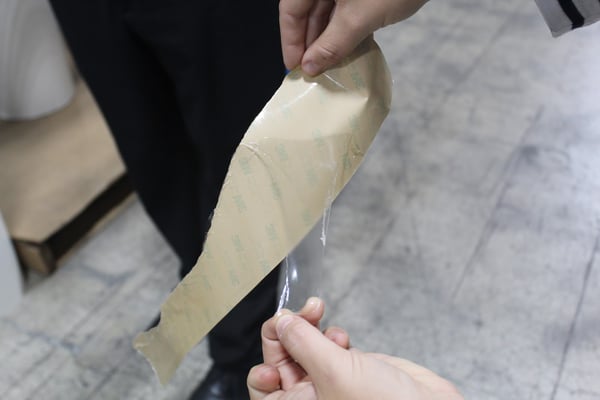
How Do I Choose the Best Adhesive Type?
Once you have the materials for your application picked out, it’s important to determine how you’re going to keep them together.
Rubber-based, acrylic-based, or otherwise, you need to find an adhesive that suits your customer’s needs. There might be consequences for product performance and lifespan if you don’t choose the best adhesive for their application.
Here are a few tips for choosing the best adhesive for any application.
Know What Factors to Consider
Selecting the best adhesive for an application starts with asking the right questions. Here are a few questions to guide your selection process:
- What are you applying the adhesive to?
- Is the application surface clean?
- Is the application surface textured or smooth?
- What is the operating environment of the product?
- Is this a temporary or permanent application?
- Are there any industry-specific or customer specifications that need to be met?
When looking at the surface(s) of your product, you have to consider its surface energy, if the surface is clean or will be cleaned, and whether it is textured or smooth. The type of adhesive you need will change depending on these factors.
The operating environment will also play an important role in your decision. The temperature and environmental factors that the adhesive is exposed to can reduce tack and threaten the integrity of the product.
You also need to understand how long the adhesive will be applied to the product. Some adhesives are temporary or removable, while others are permanent. There are specific adhesive types for all these applications.
Another set of components to consider is industry and customer specifications. Most adhesives need to be Underwriters Laboratory (UL) certified, which means that they meet the safety standards relevant to the industry you’re working in. It’s important to find the right adhesive for the application, but it’s even more crucial to ensure it meets safety requirements.
By keeping these factors in mind, you can make the best adhesive choice for any application.

Why Do Low VOC Materials Matter in Automotive Applications?
Recently, there has been a push in the automotive industry towards more environmentally friendly products that give off less air pollution. This push starts with low VOC materials.
Volatile organic compounds (VOCs) are airborne chemicals emitted from certain materials that are harmful when inhaled. They are created as the result of high VOC materials such as adhesives, rubbers, plastics, foams, fabrics, and leathers off-gassing and vaporizing, which put those chemical emissions into the air. Adhesives are the most prominent source of VOC emissions.
The “new car smell” that many people enjoy is actually a result of VOCs. The fumes that create that smell are a result of high VOC materials and can cause headaches, nose and throat irritation, and disorientation for drivers.
To reduce these emissions, you can use low VOC materials in your products, such as thermoplastics and thermosets, as well as designated low VOC adhesives from suppliers like 3M. You can also test materials and expose them to heat and air before releasing a vehicle, which will out-gas materials in a controlled environment, resulting in fewer operators being exposed to chemicals.
People spend a lot of time in their cars, so ensuring that they have the safest environment possible is important. Focus on using adhesives, foams, rubbers, fabrics, and plastics with low VOC in your interior applications to provide a cleaner environment for drivers and passengers, all while reducing atmospheric pollution as well.

Should I Use Domestic or Imported Materials?
Even once you know what materials you’re going to use, choosing the right material source for both you and your customers can be a difficult decision. Should you source materials domestically? Or should you look offshore for materials? Does the source even matter?
You need to consider and understand what the value proposition is for your customers when selecting a material source. There are several key attributes that bring value to most customers that you should consider when it comes to material sourcing.
- Quality
- Intellectual Property (IP)
- Technology
- Manufacturing Cost
- Total Landed Cost
- On-Time Delivery
- Responsiveness
- Environmental Effect
Pros & Cons of Domestic Sourcing
Domestic material sources present you with a high-quality product, allow you to build relationships with suppliers, and enable you to verify the supplier’s manufacturing processes.
However, the manufacturing cost is higher when working with domestic sources, and there are fewer manufacturers to choose from. If your business likes to have multiple options for material sourcing, this could be an issue.
Pros & Cons of Import Sourcing
When using an offshore material source, you will have lower manufacturing costs, an increased number of suppliers to choose from, and a large labor pool to create materials for you.
Generally, offshore sources can have less respect for IP regulations, longer lead times, increased transportation costs, and risk of working with practices that cause environmental harm.
When choosing a supplier, remember to consider the factors discussed above. These factors fluctuate when looking at domestic and offshore suppliers, so make sure you find a vendor that fits the needs of your business and your customer’s business.
How Can I Get the Best Cost with a Custom Solutions Team?
Now that you’ve found the right materials, adhesives, and source for your application, you’ll want to get the best price for your order. To do this, you should understand the ordering process when working with a custom solutions team.
The major costs and fees for an order with a custom cut solutions are:
- Part Costs
- Tooling
- Quality Inspections
- Cost Downs & Payment Terms
The price of part encompasses aspects such as material, labor, and inbound freight costs, with the material cost being the most influential in the overall cost.
The tooling cost will be based upon whether you decide to use a hard-tool, special tooling, or a digital cutting program. Hard-tooling is best-suited for large orders, while CNC tooling works best for smaller orders.
It takes time to set up and prepare presses to run. The setup time charges the same rate as any other point in the process, meaning that the time it takes to get a press running is factored in with the time that the job is actually running. This can be leveraged by giving the cut team larger release quantities.
Once the parts are made, some customers also require FAI (First Article Inspection) or PPAP (Production Part Approval Process) with their orders. These are both lengthy inspection processes that can carry fees if specified by the customer.
While all previous factors have been a source of added fees, there are opportunities for discounts as well. Year over year cost downs are when customers get discounts by year after agreeing to do business. For example, the price of an order can decrease by 3% until your agreement ends. Extended terms are also a potential source of discounts, as they influence how soon you have to pay for your order.
You can get the best cost for your order by keeping these factors in mind, as well as choosing the right material vendor, determining the best material yield, and selecting the right manufacturing process.

How Do I Choose the Right Materials for My Application?
This guide and its collection of resources is the first step to ensuring that you select the best materials for whatever your application might be. The transportation industry is ever-evolving, so keeping the factors and questions we have discussed in mind will be crucial for ensuring success no matter where the market goes.
Whether you’re designing entire vehicles or trunk and door components, making sure you understand your options, select the right material type for you, source it from the most logical place, and get the best cost for it is key for creating products that satisfy both you and your customers.
Use the information in this guide to address all the factors we discussed with confidence. Remember, great products begin with great materials. With this guide, you know how to make the right choice for every application and can get to work creating better products today.






